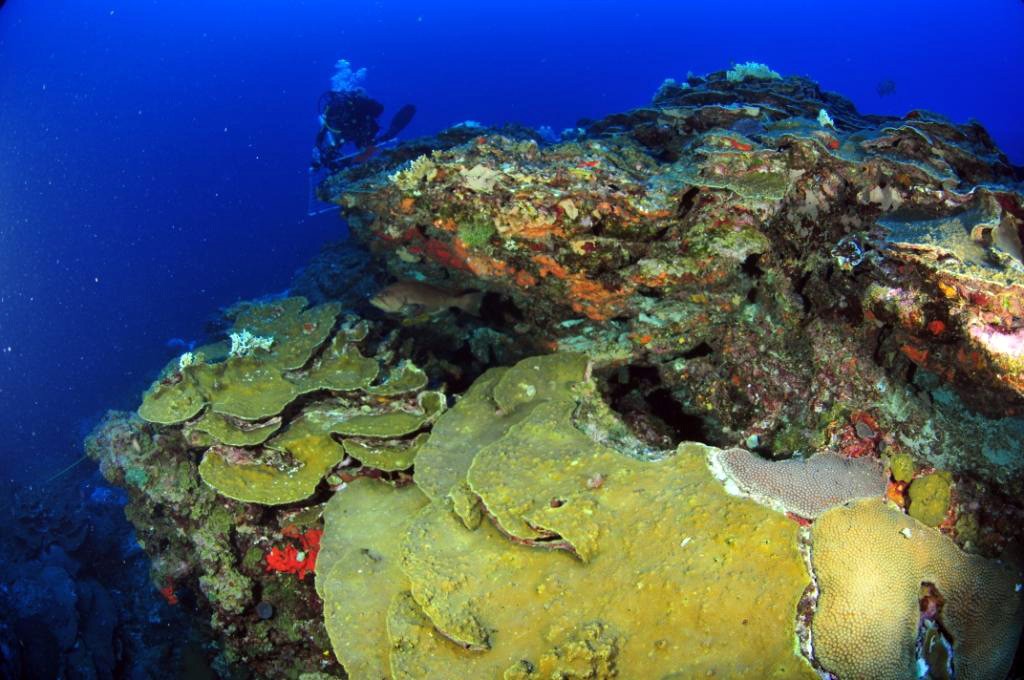AOML scientists recently traveled to two remote reef locations to expand the National Coral Reef Monitoring Program’s (NCRMP) network of sentinel climate and ocean acidification monitoring sites. The newly established sites, located in the Flower Garden Banks and the Dry Tortugas, will provide researchers with additional data and insights into the ocean’s changing chemistry and the progression of ocean acidification, as well as the ecological impacts of these variables across the Caribbean basin and the Gulf of Mexico.

Both sentinel sites are located in remote regions of the Gulf of Mexico that experience few impacts from man-made stressors such as overfishing and pollution from land. The team will monitor the physical and chemical conditions at the two sites over time, as well as closely monitor ecosystem impacts to the reefs due to ocean acidification such as species-specific calcification rates, calcium carbonate budgets, and rates of bioerosion, i.e., the removal of calcium carbonate structures by living organisms.
The team partnered with researchers from NOAA’s Office of National Marine Sanctuaries and academic colleagues in May to establish a sentinel site in the Flower Garden Banks National Marine Sanctuary. Located approximately 120 miles southeast of Galveston, Texas, the Flower Garden Banks include the northernmost coral reefs on the continental shelf of North America and contain some of the most pristine reefs in the Atlantic.

From aboard the NOAA R/V Manta, AOML and Sanctuary researchers conducted benthic surveys to measure ecosystem productivity and deployed monitoring units to measure calcium carbonate cycling, subsurface ocean temperatures, and rates of bioerosion. To measure historical growth rates, they collected coral cores, which are being analyzed at AOML by a state-of-the-art CT (computed tomography) scanner.
In September, AOML researchers established a monitoring site in the Dry Tortugas, there creating transects for long-term monitoring and deploying monitoring unites to track ecosystem impacts. The Dry Tortugas are a small group of islands located 70 miles west of Key West, Florida that constitute the southwestern tip of the Florida Reef Tract. The Dry Tortugas site provides a unique opportunity to compare ocean chemistry changes and ecological impacts with data gathered from Cheeca Rocks, an ocean acidification sentinel site located farther north along the Florida Reef Tract that was previously established by AOML researchers.
In addition to the Flower Garden Banks and Cheeca Rocks sentinel sites, AOML researchers also monitor and gather data from the La Parguera sentinel site in Puerto Rico. Sentinel sites in the Pacific are located in Oahu’s Kaneohe Bay, Hawaii, American Samoa, and Saipan in the Commonwealth of the Northern Mariana Islands. Data from these sentinel sites contribute to NCRMP’s goal of providing sustained and long-term measurements of key variables to gauge the status and trends in coral reef health.
The NCRMP work, co-funded by NOAA’s Coral Reef Conservation Program and Ocean Acidification Program, also incorporates the Atlantic Ocean Acidification Test-Bed, which, in collaboration with academic and other governmental partners, tests and improves current and newly developed methodologies to understand and interpret the effects of ocean acidification on coral reefs. Data from the sentinel sites also contribute to the efforts of the larger Global Ocean Acidification Monitoring Network.

Aside from leading the in-situ climate change and ocean acidification monitoring for the Atlantic Ocean, AOML’s team of coral scientists works collaboratively with NOAA’s Pacific Marine Environmental Laboratory in Seattle, Washington and the Coral Reef Ecosystems Division of the Pacific Islands Fisheries Science Center in Honolulu, Hawaii, to ensure that monitoring efforts in the Atlantic and Pacific are aligned.
